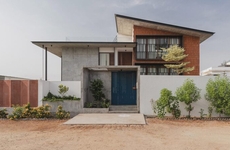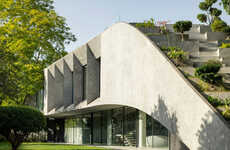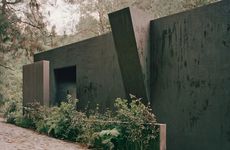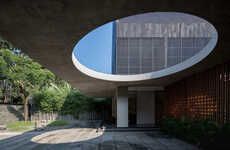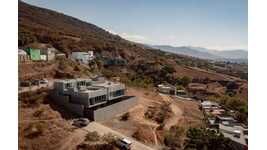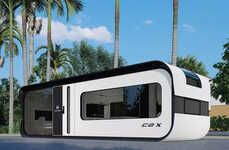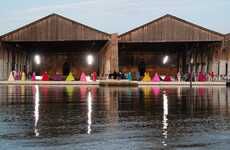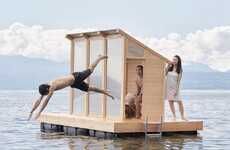
The IH Residence Features a Giant Concrete Roof
Elena Rahman — August 5, 2021 — Art & Design
References: andramatin & dezeen
IH Residence in Bandung, Indonesia, was built by architecture studio Andramatin. The studio used a large, overhanging concrete roof to protect the glass-walled building from direct sunlight and heavy rainfall. IH Residence is a reinterpreted version of Dutch colonial manor houses.
Its concrete design contrasts the site's sloping gardens, bringing nature and industrial styles together. A series of sunken pools, bridges, and ramps decorate the home's surrounding landscape. Between the house's structure and the concrete roof is a shadow gap due to the roof's slight elevation. On the inside, the house creates different degrees of openness. The glass walls overlook a series of calming pools to the west, thereby blending the indoors and outdoors to create a versatile space.
Image Credit: Andramatin
Its concrete design contrasts the site's sloping gardens, bringing nature and industrial styles together. A series of sunken pools, bridges, and ramps decorate the home's surrounding landscape. Between the house's structure and the concrete roof is a shadow gap due to the roof's slight elevation. On the inside, the house creates different degrees of openness. The glass walls overlook a series of calming pools to the west, thereby blending the indoors and outdoors to create a versatile space.
Image Credit: Andramatin
Trend Themes
1. Concrete-roofed Houses - The trend towards using concrete roofs in architecture creates a new space for innovation, particularly in the area of sustainable construction.
2. Glass-walled Buildings - The trend of constructing homes using glass walls is on the rise due to its ability to create a seamless indoor/outdoor living experience, opening the door for new technological approaches to home construction.
3. Nature-inspired Architecture - A trend towards incorporating elements of nature into architectural designs has created opportunities to create innovative, sustainable buildings that prioritize environmental protection.
Industry Implications
1. Architecture - The field of architecture is at the forefront of redefining how structures are designed and constructed, and new developments in materials and technology are key to advancing the industry.
2. Construction - Innovations in construction methods and materials are creating opportunities to develop environmentally sustainable structures that meet the needs of contemporary living.
3. Interior Design - As new materials and technologies become available for construction, designers have more flexibility in creating interiors that are both functional and aesthetically pleasing.
4.3
Score
Popularity
Activity
Freshness


